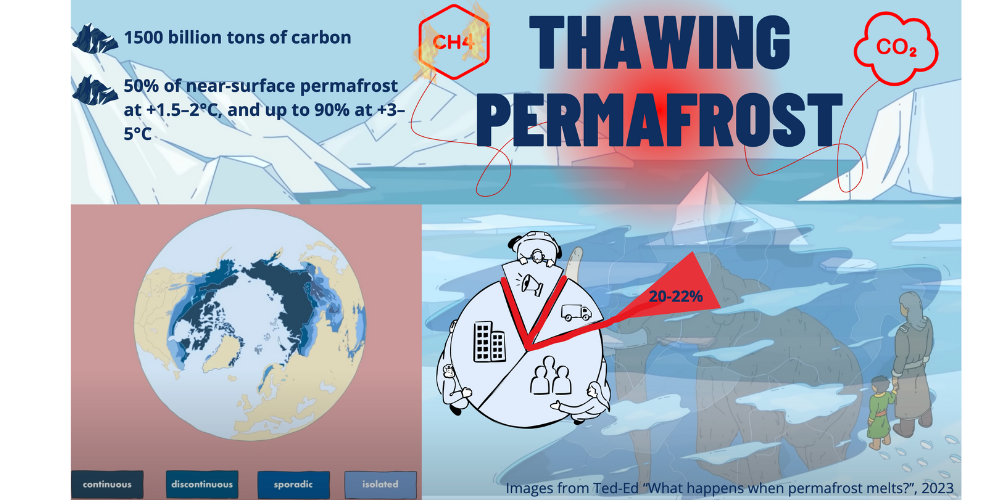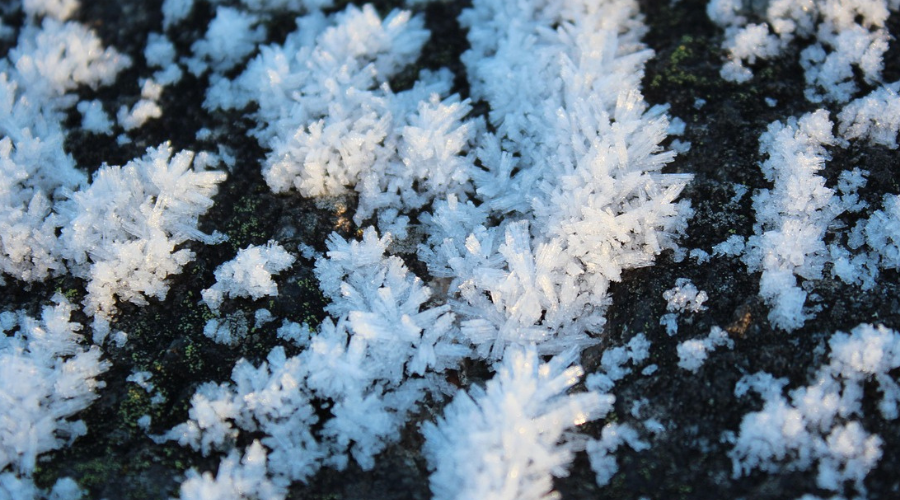
Air Pollution in Poland: a Climate and Health Emergency
1 August 2025
Women on the Frontlines: The Unequal Health Impact of Climate Change and the Urgent Need for Gender-Inclusive Climate Policies
1 August 2025By Apolline DELAGRANGE
To : the insitutions in charge of developing France’s carbon budgets (the High Council for Climate, the Ministry of Ecological Transition, CITEPA – Centre Interprofessionnel Technique d’Études de la Pollution Atmosphérique).
Long symbolized by stranded polar bears as a victim of global warming, the northern hemisphere is now also becoming a major contributor to greenhouse gas emissions due to thawing permafrost. Defined as ground (soil, rock, ice or organic matter) that remains frozen for at least two consecutive years, permafrost stores vast amounts of carbon and methane that are released as it thaws. This triggers a feedback loop that accelerates warming and threatens global climate targets by adding a natural, hard-to-limit source of emissions.
Permafrost stores about 1 500 billion tonnes of organic carbon, twice the amount currently in the atmosphere. As it thaws, permafrost releases both carbon dioxide and methane, through aerobic decomposition, thermokarst formation, changes in vegetation, fires or the development of methane-producing microbes in waterlogged conditions. Thawing is projected to affect 50% of near-surface permafrost at 1.5–2°C of warming, and up to 90% at 3–5°C. Once freed, the gases cannot be refrozen or recaptured on human timescales, making the process largely irreversible over centuries. This phenomenon is particularly alarming knowing that methane is over 80 times more effective than carbon dioxide at trapping heat in the atmosphere over a 20-year period.
While the release of greenhouse gases from permafrost is now considered inevitable, there is significant uncertainty regarding the timing and magnitude of greenhouse gas emissions from thawing permafrost. Current climate models fail to accurately capture this phenomenon, particularly because abrupt thaw and tundra fires are excluded. Adjusted estimates suggest that permafrost feedbacks could reduce the carbon budgets needed to meet the 1.5°C and 2°C targets by up to 20–22%. This gap highlights the urgent need for more comprehensive integration of permafrost dynamics in both climate models and policy frameworks.
Permafrost thaw not only accelerates global warming but poses substantial economic, scientific, and health risks. The economic damage is evaluated at trillions of dollars. Permafrost also serves as a time capsule of times long gone for scientific discoveries. The oldest permafrost, dating back 740 000 years, has preserved well-known fossils, including a 30 000-year-old mammoth discovered in 2022 or 32 000-year-old seeds that were rehydrated in 2012. Frozen soils have preserved not only ancient fossils, but also dangerous dormant microorganisms which are reactivated as the ground warms, such as Bacillus anthracis, the bacteria responsible for anthrax.
To mitigate these risks, the French Stratégie Nationale Bas-Carbone (SNBC) should explicitly account for emissions from thawing permafrost in its carbon budgets. This includes integrating permafrost dynamics into planning, supporting international research, and strengthening monitoring efforts in Arctic regions. Ignoring this major feedback loop undermines the credibility and achievability of climate targets.
As Philippe Cousteau Jr. aptly stated, “The Arctic affects every living thing on Earth,” underscoring the importance of addressing permafrost thaw in all national climate strategies, even for countries that seem for away. Failing to integrate this feedback loop into climate planning is not only a scientific oversight, but a political blind spot.

References
Vladimir E. Romanovsky et al., “Frozen Ground,” in Global Outlook for Ice and Snow, ed. United Nations Environment Programme (Arendal, Norway: UNEP/GRID, 2007), 181–200.
Susan M. Natali et al., “Large Loss of CO₂ in Winter Observed Across the Northern Permafrost Region,” Nature Climate Change 11 (2021): 304–310.
Tarnocai, C. et al. Soil organic carbon pools in the northern circumpolar permafrost region. Glob. Biogeochem. Cycles 23, GB2023 (2009).
McCalley, C., Woodcroft, B., Hodgkins, S. et al. Methane dynamics regulated by microbial community response to permafrost thaw. Nature 514, 478–481 (2014).
IPCC. AR6 WG1 Summary for Policymakers, 2021, SPM B.5.4 and Figure SPM.8.
Schuur, E.A.G., et al. “Climate Change and the Permafrost Carbon Feedback.” Nature 520 (2015): 171–179.
Intergovernmental Panel on Climate Change (IPCC), Climate Change 2021: The Physical Science Basis. Contribution of Working Group I to the Sixth Assessment Report of the IPCC (Cambridge: Cambridge University Press, 2021), Chapter 7, p. 1012
Schuur, E.A.G., et al. “Climate Change and the Permafrost Carbon Feedback.” Nature 520 (2015): 171–179.
Miner, K.R., Turetsky, M.R., Malina, E. et al. Permafrost carbon emissions in a changing Arctic. Nat Rev Earth Environ 3, 55–67 (2022).
Mack, M., Bret-Harte, M., Hollingsworth, T. et al. Carbon loss from an unprecedented Arctic tundra wildfire. Nature 475, 489–492 (2011).
Rachael Treharne, Thomas Gasser, Brendan M. Rogers, Merritt R. Turetsky, et al., “Comprehensive assessment of permafrost carbon emissions indicates need for urgent action to keep Paris Agreement temperature goals within reach,” Research Square, preprint, accessed April 2025.
National Research Council. Abrupt Impacts of Climate Change: Anticipating Surprises (The National Academies Press, 2013) and Hope, C. and K. Schaefer. Economic impacts of carbon dioxide and methane released from thawing permafrost. Nature Climate Change (2015).
Yu, Y., et al. “Reviving ancient bacteria from permafrost: The risk of pathogen emergence.” Proceedings of the National Academy of Sciences 111, no. 9 (2014): 3246-3251.


